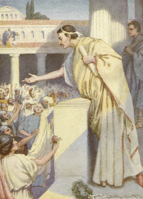Colosseum

The Colosseum, or the Coliseum, originally the Flavian Amphitheatre (Latin: Amphitheatrum Flavium, Italian Anfiteatro Flavio or Colosseo), has amazed and inspired visitors from near and abroad for centuries. Many a traveler has gazed upon this ancient masterpiece of architecture and wondered to themselves just what size pastries will mankind achieve in the future.
Conception of design[edit | edit source]
Construction of the Colosseum began under the rule of the Emperor Vespasian in around 70-72. As Vespasian was taking a relaxing bath after a long day of oppressing the known world, one of his servants brought him a tray of newly invented doughnuts. Vespasian, upon trying one, was delightfully surprised and purportedly uttered "Ego operor non vere teneo quam oro Latin" (Doughnuts are to me, as Christians are to lions.)The rest of Vespasian's rein was dominated by his affection for doughnuts, culminating finally in the construction of a giant Doughnut mold. Many an advisor attempted to
dissuade The Emperor from this reckless enterprise. But undaunted by his certain inability to actually eat even a small portion of the envisioned doughnut, Vespasian pushed ahead with the plans. It was to be his downfall.
Construction[edit | edit source]
After much debate engineers settled on stone and slave labor for construction, a radically different approach for ancient times. The materials necessary for the mold were putting a great strain upon the Empire's finances not mention the Doughnut ingredients themselves. Vespasian's popularity amongst the nobles plummeted, for his preoccupation with doughnut baking had diverted him from making war, leaving the upper classes' thirst for blood and riches unquenched. The peasants were also unhappy that the grain required for such a gargantuan pastry would starve them and there families to death, but this was secondary.
So one night in 79 A.D. as he sat studying cookbooks Vespasian was stabbed to death by assassins sent by his adversaries. The succeeding emperor, Titus, completed the structure in 80 A.D. and many foreigners and wild animals were killed in celebration. Little did they know, just the day before Vespasian had dedicated the Doughnut-in-progress to almighty Jupiter. It was to be a costly error, jupiter only likes flapjacks!!!! .
Disuse and Divine wrath[edit | edit source]
For most of his reign Titus was preoccupied with killing people who believed different things than him, and the Coliseum was never put use for its intended purpose. Over the years different emperors came and went, as the Coliseum gathered dust, which collected in the middle to create a sand bed. The ignorant masses eventually tore down the crumbling inner walls and used it as an arena, its original purpose long forgotten.
The Roman Empire fell on hard times in the Crisis of the Third Century, and people wondered what they had done to anger the Gods so. During an official sacrifice in the capital a bolt of lightning (that may or may not have been thrown by all or any of Zeus, Jupiter, Thor, God, or Jaweh) Struck the Coliseum causing a great fire that left it and much of the city severely damaged. The people were in panic over this ill omen, complicated by troubles abroad and corruption with in. It appeared as if the mighty Roman Empire was finally at an end.
And a fucking random point:
Nobody ever came to the coliseum. They thought it was spelt colliseum and they saw enough men fighting tigers in their underwear. They preferred to watch it on TV. Why? BECAUSE THEY WERE TOO FUCKING LAZY!!!!!!!!!!!!!!!!!!!!!!!!!!!!!!!!!!!
Rediscovery and Salvation[edit | edit source]
It is around this time that we begin to hear of one Latvenum the Elder. To the great amusement of his fellow citizens, Latvenum claims to have found an ancient scroll detailing the true purpose of the Coliseum, and the cause of the Empire's troubles. Laughed off by his peers, and finally accused treason, Latvenum was sentenced to be fed to Rhinoceroses in, ironically, the Coliseum. The Romans, not knowing yet that despite their fearsome appearance Rhinoceroses are actually herbivores, were amazed at Latvenum's survival. Imagining him to be some kind of divine messenger, the old scholar's warnings were finally heeded.

Under the orders of current Emperor Diocletian, The Arena was re-modified back into its original mold state, and baking began immediately. Soon into it however, a great controversy erupted as over to what type of doughnut was to be molded. Several factions representing their preferred flavor had heated debates in the public forums, sometimes degenerating into mob violence, and barely stopping short of military conflict. In the end, through a series of brilliant speeches, and throat cutting the Plain Old Glazed faction prevailed. Prosperity and peace once more returned to the land. But not for long.
Conclusion[edit | edit source]
Some of it was eaten, most of it molded over, and all of it pissed off the Gods. In their holy fury they condemned Rome to slow decline over the next few hundred years, but the Coliseum remained. As a monument to mankind's ingenuity and power, to humanity's cruelty and foolishness, and to people's fondness for sticky sweet fried things.

